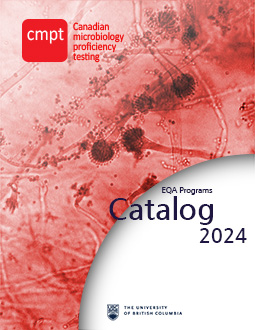CLINICAL BACTERIOLOGY
Grading scheme is on a 4-point scale, and addresses identification, urine colony count, antimicrobial susceptibility testing, Gram stain analysis and interpretation, and importantly, clinical relevancy reporting of the challenge.
Over the years, CMPT has reported to laboratories in a number of formats.
- Between 1982 and 1986 CMPT used numeric grading based on a 3-2-1 evaluation. This grading scheme was too linear and did not fairly distinguish performance so it was replaced with an excellent-acceptable-unacceptable (E-A-U) format.
- As samples evolved to a more clinically oriented scale, the E-A-U format became less workable. As an interim format, CMPT adopted a two-point scale (acceptable or unacceptable).
- In May 1999, CMPT changed its grading process to the new numeric-grading format (0, 1, 3, 4) as shown in Grading Table (pdf).
Suitability for Grading
A challenge is considered suitable for grading if agreement is reached by 80 percent of selected reference group and at least 50 percent of the participants.
ENTERIC PARASITOLOGY
Grading is based on a 2-point scale (acceptable or unacceptable). For grading purposes, when a sample consists of paired results (a concentrate and stained smear), grades are based on the results of the combined pair.
See assessment scale (pdf).
Suitability for Grading
A challenge is considered suitable for grading if agreement is reached by the two reference labs and at least 70 percent of the participants.
WATER MICROBIOLOGY
Challenges are graded against the Guidelines for Canadian Drinking Water Quality (4th edition) Health and Welfare Canada.
See Water Grading Schemes (pdf)
Measurement Uncertainty:
CMPT uses the following formula to calculate the Measurement Uncertainty for all internal QA/QC samples tested:
Fractional Uncertainty = Standard Deviation or Uncertainty in count ÷ Mean
Percentage Uncertainty = [Standard Deviation ÷ Mean] x 100%
Measurement Uncertainty (MU) can be defined as the ratio of the standard deviation to the mean (coefficient of variation). It measures the variability or dispersion of observed values in a frequency distribution.
This standardized measure shows the allowable variability in relation to the group mean of the distribution and has been expressed in percentage next to the result. It provides similar information as estimates of Allowable Error or Total Allowable Error.
CLOSTRIDIOIDES DIFFICILE
Results for this program are reported as Positive / Negative, thus grading is based on a 2-point scale: Acceptable / Unacceptable.
SHIGA TOXIN
Results for this program are reported as Positive / Negative, thus grading is based on a 2-point scale: Acceptable / Unacceptable.
TRICHOMONAS VAGINALIS
Results for this program are reported as Positive / Negative, thus grading is based on a 2-point scale: Acceptable / Unacceptable.
SCREENING BACTERIOLOGY
Results for this program are reported as Positive / Negative, thus grading is based on a 2-point scale: Acceptable / Unacceptable.
ENTERIC PANEL
Results for this program are reported as Positive / Negative, thus grading is based on a 2-point scale: Acceptable / Unacceptable.
RESPIRATORY PANEL AND COVID-19
Results for this program are reported as Positive / Negative, thus grading is based on a 2-point scale: Acceptable / Unacceptable.
ACID FAST BACILLI (AFB)
Results for this program are reported as Positive / Negative, thus grading is based on a 2-point scale: Acceptable / Unacceptable.
MYCOLOGY
Grading is based on a 2-point scale (acceptable or unacceptable)




